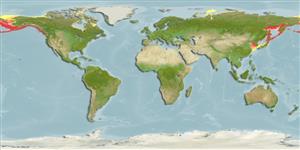Environment: milieu / climate zone / depth range / distribution range
Ecologia
marino demersale; distribuzione batimetrica 0 - 325 m (Ref. 6793). Temperate
North Pacific: Sea of Japan and the Sea of Okhotsk to the Chukchi Peninsula and Norton Sound, Alaska to Kiska Island in the Aleutian chain and southeastern Alaska.
Size / Peso / Age
Maturity: Lm ? range ? - ? cm
Max length : 28.0 cm TL maschio/sesso non determinato; (Ref. 56557); common length : 19.5 cm TL maschio/sesso non determinato; (Ref. 56557); peso massimo pubblicato: 240.00 g (Ref. 56557); Età massima riportata: 12 anni (Ref. 56557)
Short description
Chiavi di identificazione | Morfologia | Morfometria
Spine dorsali (totale) : 9 - 11; Raggi dorsali molli (totale) : 13 - 16; Spine anali: 0; Raggi anali molli: 14 - 18. A few bony plates usually present on median line of interorbital space (Ref. 559). Supraocular cirrus absent in adults (Ref. 559). Three pairs of bony tubercles on occiput (Ref. 559). Cleithral spine not developed (Ref. 559). In males, spatulate cirri present on pectoral axil (Ref. 559).
Life cycle and mating behavior
Maturities | Riproduzione | Spawnings | Egg(s) | Fecundities | Larve
Eschmeyer, W.N., E.S. Herald and H. Hammann, 1983. A field guide to Pacific coast fishes of North America. Boston (MA, USA): Houghton Mifflin Company. xii+336 p. (Ref. 2850)
IUCN Red List Status (Ref. 130435)
Threat to humans
Harmless
Human uses
Strumenti
Special reports
Download XML
Fonti Internet
Estimates based on models
Preferred temperature (Ref.
123201): -1.2 - 6.4, mean 1.7 °C (based on 722 cells).
Phylogenetic diversity index (Ref.
82804): PD
50 = 0.5078 [Uniqueness, from 0.5 = low to 2.0 = high].
Bayesian length-weight: a=0.00891 (0.00562 - 0.01412), b=3.08 (2.94 - 3.22), in cm total length, based on LWR estimates for this species & (Sub)family-body (Ref.
93245).
Trophic level (Ref.
69278): 3.1 ±0.26 se; based on food items.
Resilienza (Ref.
120179): Medio, tempo minimo di raddoppiamento della popolazione 1.4 - 4.4 anni (tmax=9-10;k=0.2-0.4).
Fishing Vulnerability (Ref.
59153): Moderate to high vulnerability (46 of 100).
